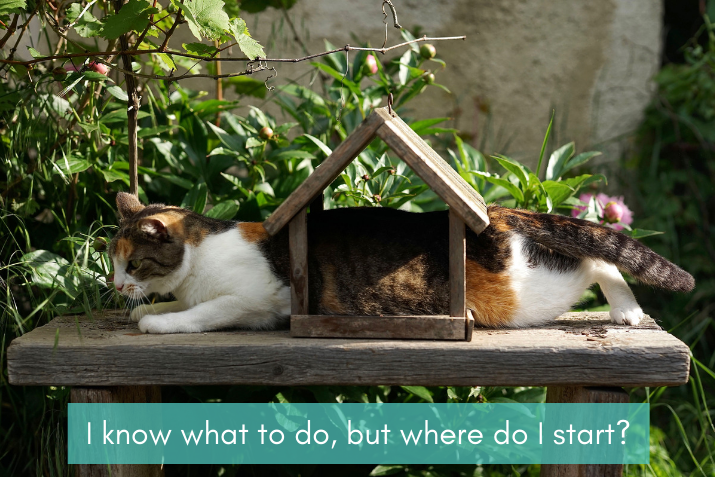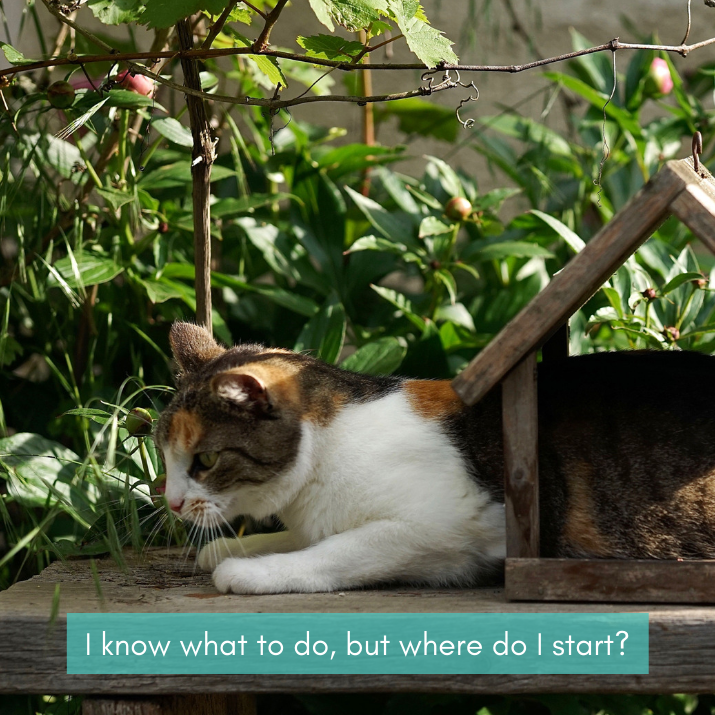
When it comes to getting organised at home, most of us know what we need to do, but we get stuck at knowing where to start. I was reminded of this issue as I was going through the PWK Annual Survey from last year. Here is a snippet of the questions that were left for me on this issue of getting started:
- Where to start in organising the home (after the day-to-day things are sorted)?
- Tips on how to start getting motivated & keeping the routines going
- Overwhelm….my house is so far gone I have apoplexy trying to work out where to start….help!
- How did you start?, I’m trying to make changes to my life and route, how did you do it?
There tend to be three key reasons why we don’t know where to start:
- We have so many tasks / activities / ideas floating in our head, we can’t work out which is more important.
- We have big visions of how extremely organised we want things at home.
- We are scared of the extra work involved, when we feel like we are already working so hard.
Today I am going to be briefly address the three factors possibly getting in your way and tips on how you can get started!
We have so many tasks / activities / ideas floating in our head, we can’t work out which is more important.
Grab a notebook and write down everything that is floating in your head, all the plans you want to try, routines you want to get the kids onto, all the extra bits and pieces that deal with home organisation and home admin (there is a lot of it!). Write without fear that you will actually have to do all of this work, but write it all out so you can clear some space in your head. It is harder to concentrate on other things when these invisible or not so invisible tasks are cluttering things in your mind.
Once you have your master list, group like activities – eg if you wrote down start menu planning and start meal prepping, put them together. Then put all the stray items – the single one off type items and put them in a list.
Now reflect on what are the biggest issues for your family at the moment? Is it:
- Dinner time is always rushed and late.
- You are always running things to kids who have forgotten their stuff at home.
- You feel that you are the only one who cleans up the house.
- The washing is never under control.
Choose one plan or process that will solve your problem. Yes there is plenty on the list that you need to work on, but just start with one, the one that will make the biggest difference in family life at the moment. Work on that one plan until it is established and you can feel the difference, then you can go back to your list and start on another plan that will solve what is now the biggest issue.
We have big visions of how extremely organised we want things at home.
Sometimes we don’t act because the task seems to impossibly big for us to complete. We have the best of intentions and plans but executions fails because we can’t find a pocket of time big enough to get started or find enough energy and patience to work with the family to get them onside.
If you feel like this, then it is time to break things down into smaller more doable tasks. It doesn’t mean you have to let go of your big vision, but you may have to be more realistic about how quickly it is attained and the manner in which it is attained.
Again grab a notebook and write down what your big vision of what organised family life looks like to you. Underneath it, write down all the individual steps that need to occur to reach that end vision. Write them in any order as you are thinking about it and then once finished re-order them in terms of the what needs to happen first, second, third etc.
Start at step one and focus only on that step, don’t worry about what is coming next, just focus on moving forward. Complete or fully establish step one and then move on to the next.
We are scared of the extra work involved, when we feel like we are already working so hard.
Getting organised does take work, but often the thought of doing the work is scarier than what it actually is. Menu planning for example is a bit like that. Thinking about menu planning for a month, you might think this is going to take hours, but in reality it takes only about 30 – 45 minutes. To get over this factor I have too key pieces of advice:
- Don’t allow your feelings to determine whether or not you do the work – I often don’t feel like cleaning or feel like menu planning, but I do it anyway and I am always glad I did. Don’t let a little bit of fear or trepidation be an excuse to not get started.
- The work is worth the effort – when starting routines, plans etc, especially with kids does take time and effort, but as I noted in last week’s newsletter, it is an effort that pays dividends in the long term. As you are doing the work, think about the long term benefits of what you are doing.
I really hope if you have been feeling a bit stuck, then these tips will get you going! If you feel like you still need more help, then Planned + Present can help!

Planned + Present is a seven week e-course to take you from feeling our of control and overwhelmed to feeling planned and present. It is a step-by-step guide on how to organise the chaos of family life while still leaving space to enjoy it. The course will deliver to you:
- Clarity and confidence to deal with competing interests – by determining your “why” you can make navigating this minefield much easier.
- Creation of positive habits – through learning about why habits work and how you can fit them into your life permanently.
- Routines, processes and plans to organise the chaos of family life – there are templates for you to use and routines to follow, so you don’t have to start from scratch
- Restored calm to daily life – with disorganisation comes stress, tension and decreased family harmony. Move to a planned approach and see how much calmer family life becomes.
Planned and Present includes seven in-depth lessons, for you to work through. And with lifetime access to the course, you can take it at your own pace.
To find out more about Planned & Present and sign up for the course head here – Planned & Present.

